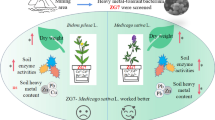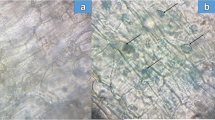Abstract
In order to assess the ecological risk generated by the accumulation of heavy metals in saline soils, several studies have been carried out to determine the ability of plants to reduce the effect of heavy metals in polluted soils and their ability to be used in the phytoextraction process. Therefore, this study was performed on plants growing in soil artificially contaminated with aluminum (Al) and was used to determine their phytoremediation capabilities. This research was conducted on two halophytes, Arthrocnemum indicum and Tamarix gallica. The effects of different concentrations of Al (200, 500, 800 µM) alone or combined with NaCl (200 mM) on growth, Al uptake and nutrient uptake and their putative impacts on photosynthesis were determined. The results revealed that Al altered the growth and development of Arthrocnemum indicum and Tamarix gallica. The metal accumulation depended on the species, their concentrations and even the stress levels. The root system was the main accumulating organ. The tested concentrations did not negatively influence plant metabolism and photosynthesis processes. These observations indicate that these species have various Al adoption schemes, making them good candidates for heavy metal phytoremediation in salt-polluted areas. Also, T. gallica was demonstrated to be an Al-accumulator plant.



Similar content being viewed by others
Data availability
The datasets generated during and/or analyzed during the current study are available from the corresponding author on reasonable request.
References
Ben Hsouna A, Ghneim-Herrera T, Ben Romdhane W, Dabbous A, Ben Saad R, Brini F, Abdelly C, Ben Hamed K (2020) Early effects of salt stress on the physiological and oxidative status of the halophyte Lobularia maritima. Funct Plant Biol 47:912–924. https://doi.org/10.1071/FP19303
Bojórquez-Quintal E, Escalante-Magaña C, Echevarría-Machado I, Martínez-Estévez M (2017) Aluminum, a friend or foe of higher plants in acid soils. Front Plant Sci 8:1767
Carreiras J, Pérez-Romero JA, Mateos-Naranjo E, Redondo-Gómez S, Matos AR, Caçador I, Duarte B (2021) Heavy metal pre-conditioning history modulates Spartina patens physiological tolerance along a salinity gradient. Plants 10:2072
Charvalas G, Solomou AD, Giannoulis KD, Skoufogianni E, Bartzialis D, Emmanouil C, Danalatos NG (2021) Determination of heavy metals in the territory of contaminated areas of Greece and their restoration through hyperaccumulators. Environ Sci Pollut Res Int 28:3858–3863
Chen Q, Kan Q, Wang P, Yu W, Yu Y, Zhao Y, Yu Y, Li K, Chen L (2015) Phosphorylation and interaction with the 14-3-3 protein of the plasma membrane H+-ATPase are involved in the regulation of magnesium-mediated increases in aluminum-induced citrate exudation in broad bean (Vicia faba. L). Plant Cell Physiol 56:1144–1153
Duarte B, Santos D, Marques JC, Caçador I (2013) Ecophysiological adaptations of two halophytes to salt stress: photosynthesis, PS II photochemistry and anti-oxidant feedback—implications for resilience in climate change. Plant Physiol Biochem 67:178–188
Fan J, Chen K, Xu J, ABM K, Chen Y, Chen L, Yan X (2022) Physiological effects induced by aluminium and fluoride stress in tall fescue (Festuca arundinacea Schreb). Ecotoxicol Environ Saf 231:113192
Flowers TJ, Colmer TD (2008) Salinity tolerance in halophytes. New Phytol 179:945–963
Fourati E, Vogel-Mikuš K, Wali M, Kavčič A, Gomilšek JP, Kodre A, Kelemen M, Vavpetič P, Pelicon P, Abdelly C (2020) Nickel tolerance and toxicity mechanisms in the halophyte Sesuvium portulacastrum L. as revealed by Ni localization and ligand environment studies. Environ Sci Pollut Res 27:23402–23410
Golia EE, Angelaki A, Giannoulis KD, Skoufogianni E, Bartzialis D, Cavalaris C, Vleioras S (2021) Evaluation of soil properties, irrigation and solid waste application levels on Cu and Zn uptake by industrial hemp. Agron Res 19:9299
Golia EE, Bethanis J, Ntinopoulos N, Kaffe GG, Komnou AA, Vasilou C (2023) Investigating the potential of heavy metal accumulation from hemp. The use of industrial hemp (Cannabis Sativa L.) for phytoremediation of heavily and moderated polluted soils. Sustain Chem Pharm 31:1961
Guo P, Qi YP, Cai YT, Yang TY, Yang LT, Huang ZR, Chen LS (2018) Aluminum effects on photosynthesis, reactive oxygen species and methylglyoxal detoxification in two citrus species differing in aluminum tolerance. Tree Physiol 38:1548–1565
Jansen S, Robbrecht Broadley MR, Smets EE (2002) Aluminum hyperaccumulation in angiosperms: a review of if phylogenetic significance. Bot Rev 68:235–269
Ievinsh G, Landorfa-Svalbe Z, Andersone-Ozola U, Karlsons A, Osvalde A (2022) Salinity and heavy metal tolerance, and phytoextraction potential of Ranunculus sceleratus plants from a sandy coastal beach. Life 12:1959. https://doi.org/10.3390/life12121959
Kar D, Pradhan AA, Datta S (2021) The role of solute transporters in aluminum toxicity and tolerance. Physiol Plant 171:638–652
Khan A, Khan S, Khan MA, Aamir M, Ullah HJ, Nawab J, Rehman IU, Shah J (2018) Heavy metals effects on plant growth and dietary intake of trace metals in vegetables cultivated in contaminated soil. Int J Environ Sci Technol 16:2295–2304
Li J, Hussain T, Feng X, Guo K, Chen H, Yang C, Liu X (2019) Comparative study on the resistance of Suaeda glauca and Suaeda salsa to drought, salt, and alkali stresses. Ecol Eng 140:105593
Lian J, Liu W, Meng L, Wu J, Chao L, Zeb A, Sun Y (2021) Foliar applied polystyrene nanoplastics (PSNPs) reduce the growth and nutritional quality of lettuce (Lactuca sativa L.). Environ Pollut 280:116978
Maathuis FJM, Ahmad I, Patishtan J (2014) Regulation of Na+ fluxes in plants. Front Plant Sci 5:467
Macedo GEC, Jan VVS (2008) Effect of aluminium stress on mineral nutrition in rice cultivars differing in aluminum sensitivity. Rev Bras Eng Agríc Ambient 12:363–369
Mishra RK, Kumar J, Srivastava PK, Bashri G, Prasad SM (2017) PSII photochemistry, oxidative damage and anti-oxidative enzymes in arsenate-stressed Oryza sativa L. seedlings. Chem Ecol 33:34–50. https://doi.org/10.1080/02757540.2016.1265516
Mujeeb A, Abideen Z, Aziz I, Sharif N, Hussain MI, Qureshi AS, Yang HH (2023) Phytoremediation of potentially toxic elements from contaminated saline soils using Salvadora persica L.: seasonal evaluation. Plants 12:598
Naeem M, Aftab T, Ansari AA, Shabbir A, Khan MMA, Uddin M (2019) Arsenic exposure modulates physiological attributes and artemisinin biosynthesis in Artemisia annua L. Int J Herb Med 7:19–26
Nisar F, Gul B, Ajmal Khan M, Hameed A (2019) Germination and recovery responses of heteromorphic seeds of two co-occurring Arthrocnemum species to salinity, temperature and light. S Afr J Bot 121:143–151
Nisar F, Gul B, Aziz I, Hameed A, Egan T (2021) Increasing salinity leads to differential growth and H2O2 homeostasis in plants produced from heteromorphic seeds of the succulent halophyte Arthrocnemum indicum. Plant Physiol Biochem. https://doi.org/10.1016/j.plaphy.2021.05.029
Peng G, Lan W, Pan K (2022) Mechanisms of metal tolerance in halophytes: a mini review. Bull Environ Contam Toxicol 109:671–683. https://doi.org/10.1007/s00128-022-03487-6
Rahman R, Upadhyaya H (2021) Aluminium toxicity and its tolerance in plant: a review. J Plant Biol 64:101–121
Rahman MA, Lee SH, Ji HC, Kabir AH, Jones CS, Lee KW (2018) Importance of mineral nutrition for mitigating aluminum toxicity in plants on acidic soils: current status and opportunities. Int j Mol Sci 19:3073
Rahman M, Rahman K, Sathi KS, Alam MM, Nahar K, Fujita M, Hasanuzzaman M (2021) Supplemental selenium and boron mitigate salt-induced oxidative damages in glycine max L. Plants (Basel) 10(10):2224. https://doi.org/10.3390/plants10102224
Rai R, Agrawal M, Agrawal S (2016) Impact of heavy metals on physiological processes of plants with special reference to photosynthetic system. In: Singh A, Prasad S, Singh R (eds) Plant responses to xenobiotics. Springer, Singapore, pp 127–140
Reboredo FH, Pelica J, Lidon FC, Pessoa MF, Silva MM, Guerra M, Leitão R, Ramalho JC (2021) The tolerance of Eucalyptus globulus to soil contamination with arsenic. Plan Theory 10:627. https://doi.org/10.3390/plants10040627
Sarkar B, Saha I, De AK, Ghosh A (2020) Aluminium accumulation in excess and related anti-oxidation responses in C4 weed (Amaranthus viridis L.). Physiol Mol Biol Plants 26:1583–1598. https://doi.org/10.1007/s12298-020-00840-z
Sghaier DB (2023) Assessing of salt effect in regulation of growth and antioxidant defence in Arthrocnemum indicum under arsenic stress alone or with salinity. Am J Life Sci Res 1:1–14
Sghaier DB, Duarte B, Bankaji I, Caçador I, Sleimi N (2015) Growth, chlorophyll fluorescence and mineral nutrition in the halophyte Tamarix gallica cultivated in combined stress conditions: arsenic and NaCl. J Photochem Photobiol B Biol 149:204–214
Sghaier DB, Pedro S, Diniz MS, Duarte B, Caçador I, Sleimi N (2016) Tissue localization and distribution of As and Al in the halophyte Tamarix gallica under controlled conditions. Front Mar Sci 3:274. https://doi.org/10.3389/fmars.2016.00274
Sghaier DB, Bankaji I, Pedro S, Caçador I, Sleimi N (2019) Photosynthetic behaviour and mineral nutrition of Tamarix gallica cultivated under aluminum and NaCl combined stress. Phyton 88:239–252. https://doi.org/10.32604/phyton.2019.06887
Sghaier DB, Pedro S, Duarte B, Caçador I, Sleimi N (2022) Photosynthetic responses of two salt-tolerant plants, Tamarix gallica and Arthrocnemum indicum against arsenic stress: a case study. In: Srivastava PK, Singh R, Parihar P, Prasad SM (eds) Arsenic in plants: uptake consequences and remediation techniques. Wiley, New York, pp 129–152
Shi R, Liang L, Liu W, Zeb A (2022) Kochia scoparia L., a newfound candidate halophyte, for phytoremediation of cadmium-contaminated saline soils. Environ Sci Pollut Res 29:44759–44768. https://doi.org/10.1007/s11356-022-18895-8
Sruthi P, Shackira AM, Puthur JT (2017) Heavy metal detoxifcation mechanisms in halophytes: an overview. Wetlands Ecol Manag 25:129–148
Suelee AL, Hasan SN, Kusin FM, Yusuff FM, Ibrahim ZZ (2017) Phytoremediation potential of vetiver grass (Vetiveria zizanioides) for treatment of metal contaminated water. Water Air Soil Poll 228:158
Usman K, Al-Ghouti MA, Abu-Dieyeh MH (2018) Phytoremediation: halophytes as promising heavy metal hyperaccumulators. Heavy Metals. https://doi.org/10.5772/intechopen.73879
Vromman D, Lefèvre I, Šlejkovec Z, Martínez JP, Vanhecke N, Briceño M, Kumar M, Lutts S (2016) Salinity influences arsenic resistance in the xerohalophyte Atriplex atacamensis Phil. Environ Exp Bot 126:32–43. https://doi.org/10.1016/j.envexpbot.2016.01.004
Wang Y, Yu W, Cao Y, Cai Y, Lyi SM, Wu W, Kang Y, Liang C, Liu J (2020) An exclusion mechanism is epistatic to an internal detoxification mechanism in aluminum resistance in Arabidopsis. BMC Plant Biol 12:1–12
Yao L, Wang J, Li B, Meng Y, Ma X, Si E, Yang K, Shang X, Wang H (2021) Influences of heavy metals and salt on seed germination and seedling characteristics of halophyte Halogeton glomeratus. Bull Environ Contam Toxicol 106:545–556. https://doi.org/10.1007/s00128-021-03130-w
Funding
Not applicable.
Author information
Authors and Affiliations
Contributions
DBS carried out all the experiments, assured the data analysis, and prepared the manuscript.
Corresponding author
Ethics declarations
Conflict of interest
The authors declare that they have no conflict of interest.
Ethical approval
This research did not contain any studies involving animal or human participants, nor did it take place in any private or protected areas. No specific permissions were required for the corresponding locations.
Consent to participate
Not applicable.
Consent to publish
Not applicable.
Additional information
Responsible Editor: Philippe Michaud.
Rights and permissions
Springer Nature or its licensor (e.g. a society or other partner) holds exclusive rights to this article under a publishing agreement with the author(s) or other rightsholder(s); author self-archiving of the accepted manuscript version of this article is solely governed by the terms of such publishing agreement and applicable law.
About this article
Cite this article
Sghaier, D.B. Comparative physiology of Arthrocnemum indicum and Tamarix gallica under aluminum alone or combined with NaCl. Euro-Mediterr J Environ Integr 8, 835–846 (2023). https://doi.org/10.1007/s41207-023-00408-9
Received:
Accepted:
Published:
Issue Date:
DOI: https://doi.org/10.1007/s41207-023-00408-9




